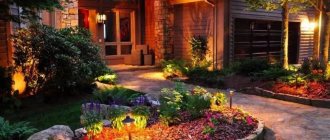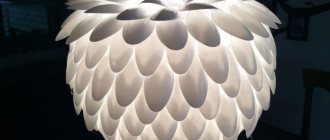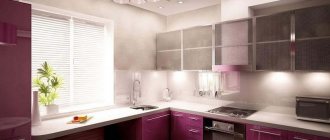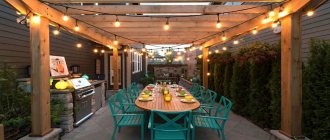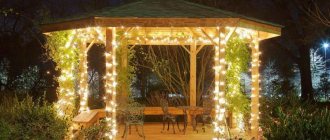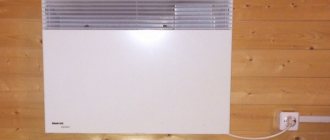/Accessories and decor/Lighting/
Proper lighting is one of the components of the effective design of any room. It is especially important in the kitchen, where the correct distribution of light flux turns cooking into a pleasant and comfortable process. All you need for this is a lighting design and calculation. One of the most interesting options in modern interiors, which you can implement with your own hands, is LED strip lighting.
LEDs are special semiconductors that emit light when electrical energy passes through them. LEDs can have different chemical compositions, which causes the brightness of the light they generate to differ. There is one more nuance - the installation of LED backlighting is never carried out directly, since this way the tape can overheat and break. A prerequisite for connecting LEDs is the presence of a stabilizer.
Advantages of LED lighting
LED lighting has a number of obvious advantages:
- Resistance to mechanical external damage;
- Durability – kitchen lighting strip can last 14 years or more even when working more than 15 hours a day;
- A variety of colors - kitchen lighting under cabinets can be made in white, red and orange, green and blue, purple and yellow. You can also choose LEDs that operate in the infrared and ultraviolet spectrum;
- Excellent lighting brightness, and the device does not require time to warm up;
- Affordability (due to distribution and popularization);
- Possibility to use tape with different radiation angles;
- Safety;
- Environmental friendliness;
- Undemanding to room temperature.
Kinds
Despite the popularity of LED chandeliers, only two types of them can be purchased on the market. This:
- ceiling chandeliers that are mounted in close proximity to the ceiling. Such lighting fixtures look very nice in any interior, since they are as close as possible to the surface of the ceiling and do not have unnecessary details that interfere with the view;
- pendant - chandeliers of this type have fastenings in the form of chains or other objects with which they are suspended from the ceiling. This is an older version of chandeliers that we are used to seeing in apartments. The only difference is the LEDs used to illuminate the room.
Methods and places for interior lighting in the kitchen
The number of crystals directly affects the number of colors in the ribbon. In general, LED strips can provide 15,000,000 shades - if they combine crystals of different brightness.
You can make LED lighting for the following purposes:
- Combined lighting for zoning, highlighting cabinets, niches;
- Illumination of paintings or other decorative elements of the interior;
- Illumination of the kitchen apron; lighting looks especially impressive if the apron is made of glass;
- Lighting inside drawers and cabinets;
- Highlighting stained glass or clear glass shelves;
- By installing lighting at the bottom of the bedside tables, that is, under the cabinets, you can create the effect of “floating furniture”;
- Lighting of several ceiling levels;
- Lighting the bar counter with LED lighting creates the atmosphere and style of a real bar.
Warm spectrum LEDs are installed for classic interiors, while in a high-tech style, cold light will be more appropriate.
Popular mistakes when organizing lighting
It is not so easy to figure out the features of arranging lighting for the work area in the kitchen on your own. Therefore, before starting work, it is useful to familiarize yourself with popular mistakes that you should try to avoid:
- Planning the lighting before arranging the kitchen . You can choose the lighting option, its power and location only in a finished kitchen. After all, during renovations, plans often change or the result may not correspond to the layout.
- Direct direction of light near the window . If in most cases the streams of light should go from top to bottom, then near the window it is better to make them at an angle, otherwise there will be glare from the glass.
- Arrangement of one light source. There is an opinion that a powerful lamp is enough for the entire kitchen. In fact, this is not so, because when working at a tabletop, the light from the ceiling lamp will rest on the person’s figure, creating a shadow that will cover the entire work area.
The kitchen should have several light sources. - Use of decorative lampshades . Devices with lampshades of unusual shapes, patterns and other decor may look beautiful, but they are not entirely suitable for the kitchen. You need to choose lamps and lamps of the simplest shapes that are easy to clean from grease and stains.
- Mixing designs . The lighting fixture should be combined with the overall style of the room. Harmony with the main chandelier in the kitchen is also important.
- Installation of different models according to light temperature . An important point, because when one part of the lighting is in warm colors and the other in cold colors, it really hurts the eyes.
At the end there is a thematic video.
Choosing a suitable LED strip - classification and comparison
Most often, LED backlight installation is made from SMD LEDs. They are classified according to a number of characteristics:
- Number of crystals – from 1 to 4;
- Glow type – full color or monochrome;
- Dimensions - in the range of 1.06x0.8 to 5.0x5.0 mm.
Before you buy an LED strip, you need to decide what type of lighting you want to make. Here are the following recommendations:
- SMD 50x50 strip with three-crystal LEDs is perfect for lighting the work and dining areas and can provide uniform bright light.
- For decorative lighting, a single-chip SMD 35x28 tape is suitable.
LED strip (LED) consists of several small LEDs located within the same plane. It can also have several varieties depending on the density of the LEDs:
- 30 pcs/meter;
- 60 pcs/meter;
- 120 pcs/meter;
- 240 pcs/meter
The power consumption and the brightness level of the generated lighting depend on the number of LEDs.
Tapes are divided into groups according to the degree of moisture protection:
- IP20 – not suitable for the kitchen because it cannot withstand high humidity;
- IP65 – average level of moisture protection, can be used in the kitchen;
- IP68 – complete moisture resistance – even a swimming pool can be illuminated with this tape.
How to choose a power supply
Power supplies come in different capacities, and therefore sizes. We need to determine the optimal option so that the power of the transformer is sufficient with a reserve, but at the same time so that it is not too large.
You can calculate the optimal power supply power for a five-meter SMD 5050 tape with a power of 12 W according to the following principle:
We multiply 12 W by 5 m (the length of the tape), for a total of 60 W. But since we need a reserve, we also take into account the coefficient equal to 1.25 - it turns out 1.25 × 60 = 75, therefore, we need to buy a 75 W transformer.
How to illuminate a tabletop or dining area with LEDs
For the work area, a device with an average degree of moisture protection is suitable - it has a special protective layer that protects against vapors and contamination, water and other liquids. This means that if wet cleaning is necessary, you can wipe down the cabinets along with the lamps.
Installing the tape to the table involves attaching a special aluminum profile. It is necessary to hide the wires and make the lighting aesthetically pleasing. You can also make lighting from self-adhesive tapes. By the way, by installing additional devices you can create a backlight that will change brightness and/or color.
Advice! A warm white LED strip color is optimal for a desktop, as it will not change the natural colors of the food.
Additional lighting can be made from LED strips in the work area. Designs with high moisture protection are also needed here. The tapes here are installed with double-sided tape. You can use several ribbons to create an expressive decorative effect.
Kitchen lighting: types, features, DIY
A modern kitchen is not only beautiful, fashionable furniture and functional household appliances that make cooking easier and faster, or, for example, washing dishes, but also competent multi-level lighting. Today, designers, when developing kitchen interiors, pay great attention to illumination of the work area, the space inside cabinets and drawers. Furniture lighting from below creates a feeling of lightness and airiness of the interior. Furniture makers often offer their own options for kitchen lighting, supplying the market with kitchen sets with already built-in lamps. If your furniture does not have such an “option”, and the kitchen lighting is far from ideal, you can correct the situation by making kitchen lighting yourself.
First you need to decide on the type of backlight. The kitchen work area can be illuminated with spotlights, linear lamps and LED strips. The choice of the type of backlight for self-production should be made by objectively assessing your skills and capabilities. If they are completely absent in this area, it is better to invite a specialist. If you have never done anything like this, but are still eager to fight, we advise you to make kitchen lighting using LED strip: it is easy to install, it looks great, and works effectively with the right selection of components.
What do we need for installation?
Self-installation of LED backlighting will require the use of the following tools and components:
- The actual kit: tape reel (12W), electrical cable with a cross section of 0.74 mm square;
- Transformer - 12W power supply and dimmer with remote control (if available);
- Solder with rosin;
- Soldering iron;
- Scissors;
- Double sided tape;
- Insulating tape (or heat shrink tube with a heat gun);
- PVC corner and or aluminum profile for LED mounting – if necessary;
- Drill - if necessary;
- Electrical installation brackets - if necessary.

